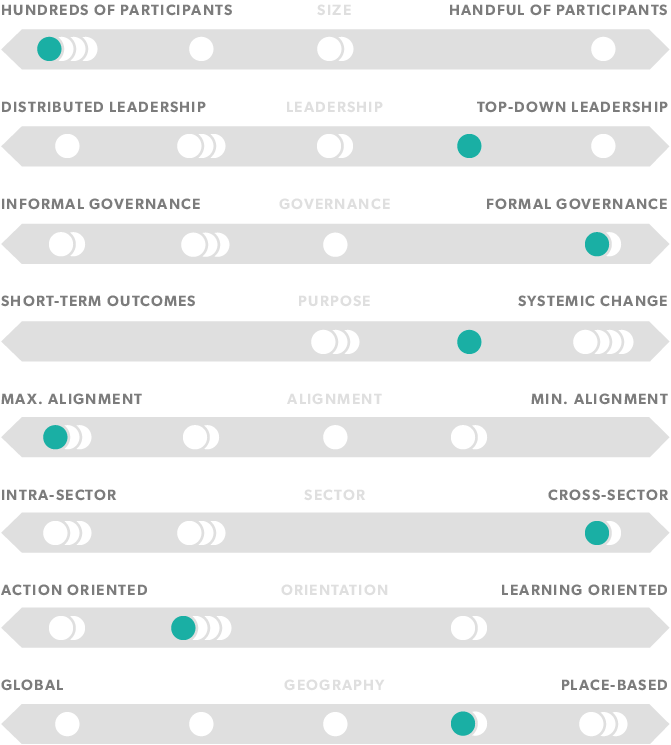SEEING THE NEED FOR A NEXT STEP
Just like an organization’s opportunities for impact often broaden once it exits its startup phase, networks often unlock new ways to achieve systemic impact once they hit their stride. The key is for supporters of the effort to see the early indicators of that opening—and find meaningful ways to engage in catalyzing them to the next stage. StrivePartnership was originally founded in 2006 by community leaders in Cincinnati and northern Kentucky to bring together the many piecemeal approaches to increasing student achievement. This approach addressed the ongoing challenge of a service landscape that was “program rich and system poor.” Within five years, 40 of the 53 educational outcomes tracked by the network had shown improvement. For example, kindergarten readiness increased 9%, high school graduation rose 11%, and college enrollment increased 10%. These gains were achieved through a cross-sectoral network of partners that addressed turf issues among the community’s educational service providers and encouraged funders to support strategies with the strongest track record. StrivePartnership’s success, and the network structure that made it possible, gained wide awareness in 2011 when it was used as the central case study of the article Collective Impact.
Many education-focused funders and nonprofits around the country had been tracking StrivePartnership’s efforts for years, considering whether a similar approach might be viable in their own communities. Substantial interest in StrivePartnership’s model began in its third year; when the outcome indicators began to move, so increased the number of inquiries about how the StrivePartnership approach could be adopted elsewhere. Seeing this as an opportunity, Living Cities provided StrivePartnership with funding to pilot a replication of its model in a few communities where there were enthusiastic champions.
LAUNCHING A NETWORK OF NETWORKS
Even though StrivePartnership itself was a well-established network, the nature of the next phase of its development was far from clear. Judy Peppler helped to start one of the early-stage pilots in Portland, Oregon. Now the President and CEO of KnowledgeWorks, she recalls the intensive effort that it took to launch these efforts on the part of Jeff Edmondson, then the Managing Director of StrivePartnership. “Jeff was running all over the country, consulting with these communities and simultaneously building out the toolkit for them to apply. His initial toolkit branched out into tools for communities that were first exploring the StrivePartnership model, those networks that were emerging, and those that were sustaining the effort. As more communities were actually making it work, he and his team continued to evolve the approach.”
The pilots’ launch showed Edmondson that it was possible to replicate the StrivePartnership model, and there was strong potential for spreading it to many more communities, but that each of those communities was going to need meaningful support in order to be successful. This caught the attention of the leadership of KnowledgeWorks, where Edmondson had been a program officer and one of the founding supporters of StrivePartnership before he took the helm as its Managing Director. KnowledgeWorks had previously functioned as a grantmaking foundation, but its trustees were looking for ways that it could evolve into a revenue-generating social enterprise. In 2011, Edmondson started a new subsidiary of KnowledgeWorks, called StriveTogether, where he began building a codified toolkit to use in helping expand the nascent network of networks that were adopting the StrivePartnership model.
ESTABLISHING A ROLE AS THE HUB
Over the past four years, StriveTogether has carved out a role for itself as the hub at the center of the group of StrivePartnership-based networks, now called the Cradle to Career Network. Unlike many funders, StriveTogether is not a participant in the network itself, but serves as the network’s governing body and in-house consultancy. Earning roughly $5 million in revenues in 2014, 30% from fees and 70% from grants, it has a staff of 25 whose time is principally spent on facilitating knowledge-sharing in three ways: convening the member networks for peer learning, improving the StriveTogether toolkit, and using that toolkit in assisting member networks directly.
As a result of this focused effort on generalizing the StrivePartnership model and using its observations to develop a clear replication framework, StriveTogether can now offer clear guidance for communities to use in adapting its model to the context-specific aspects of their environment. It has a standard Theory of Action describing what it takes for a StriveTogether partnership to be successful, gateways for a community to clear as it moves from Exploring to Emerging and finally to Sustaining, a suite of resources for communities at each level, and peer learning opportunities for those communities to help each other on their journey. Peppler sees structure and attention to detail at the heart of its value: “We’re trying build collective impact networks in a disciplined, rigorous, high-quality way that is bigger than just agreeing that ‘we’ll work on this together.’”
BY COMPARISON: THE NETWORK’S DESIGN
In the section What network design would be most useful? we introduce a simple framework for comparing the ‘design’ of a network — eight basic variables that define its shape and size. See below for our estimation of StriveTogether’s design (in teal) versus that of the other networks we profile (in white):

Sources: Monitor Institute interview with KnowledgeWorks CEO Judy Peppler in fall 2014, The StriveTogether Story, and Collective Impact (Stanford Social Innovation Review, winter 2011).

